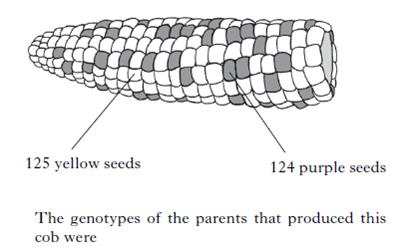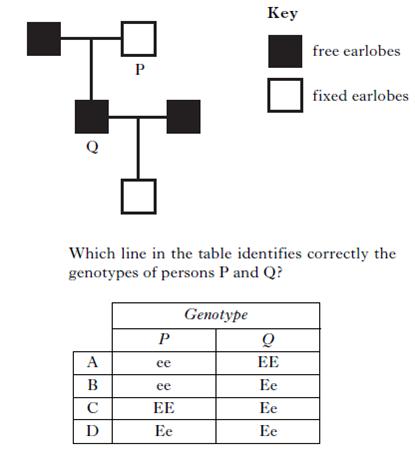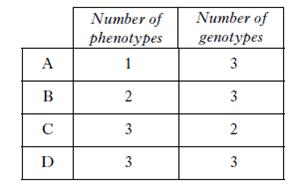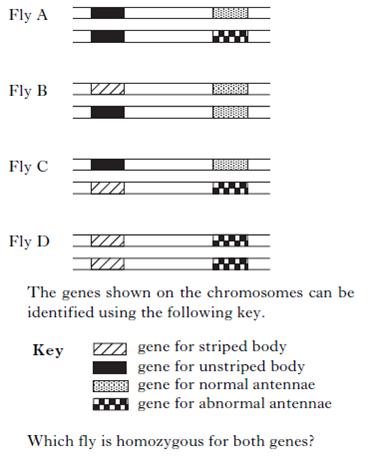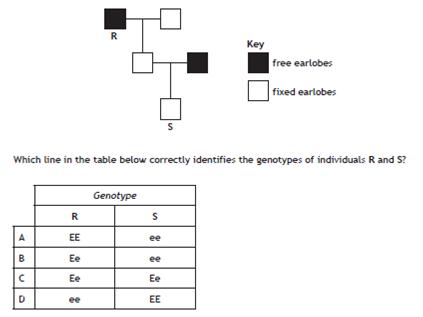| 1. | A dominant allele | |
| A. | is bigger than a recessive allele | |
| B. | is usually represented by a small letter | |
| C. | always shows up in the phenotype | |
| D. | is masked by a recessive allele | |
| 2. | A recessive allele | |
| A. | shows up in a homozygous individual | |
| B. | never shows up in the phenotype | |
| C. | always shows up in the phenotype | |
| D. | shows up in a heterozygous individual | |
| 2. | The genotype of an organism | |
| A. | describes its appearance | |
| B. | is written in words | |
| C. | is determined by its phenotype | |
| D. | is the combination of its alleles | |
| 3. | The phenotype of an organism is | |
| A. | a combination of alleles | |
| B. | masked by the genotype | |
| C. | represented by letters | |
| D. | what it looks like | |
| 4. | In a homozygous organism | |
| A. | only dominanat alleles are present | |
| B. | both alleles are identical | |
| C. | only recessive alleles are present | |
| D. | both alleles are different | |
| 5. | In a heterozygous organism, the alleles present are | |
| A. | both the same | |
| B. | different | |
| C. | both dominant | |
| D. | both recessive | |
| 6. | In mice, black coat (B) is dominant to white coat (b). A mouse with genotype bb is | |
| A. | homozygous dominant | |
| B. | black | |
| C. | homozygous recessive | |
| D. | heterozygous | |
| 7. | In mice, black coat (B) is dominant to white coat (b). A mouse with genotype Bb is | |
| A. | black | |
| B. | white | |
| C. | grey | |
| D. | spotted | |
| 8. | In mice, black coat (B) is dominant to white coat (b). A mouse with genotype Bb | |
| A. | is white | |
| B. | is homozygous recessive | |
| C. | is homozygous dominant | |
| D. | is heterozygous | |
| 9. | A monohybrid cross follows the inheritance of | |
| A. | one chracteristic | |
| B. | two characteristics | |
| C. | three characteristics | |
| D. | four characteristics | |
| 10. | All true breeding organisms | |
| A. | have the same characteristics | |
| B. | produce gametes with different characteristics | |
| C. | always pass on the same characteristic to their offspring | |
| D. | pass on different characteristics to their offspring | |
| 11. | A true breeding organism is always | |
| A. | homozygous | |
| B. | heterozygous | |
| C. | dominant | |
| D. | recessive | |
| 12. | What is the correct order of generations in a cross? | |
| A. | P, F2, F1 | |
| B. | F1, F2, P | |
| C. | P, F1, F2 | |
| D. | F2, F1, P | |
| 13. | In humans, the allele for blood group A is dominant to the allele for blood group O. Two parents both have blood group A. Their child has blood group O. What is the best explanation for this pattern of inheritance? | |
| A. | The child has inherited the blood group directly from a grandparent | |
| B. | The parents are homozygous for the blood group alleles | |
| C. | The parents are heterozygous for the blood group alleles | |
| D. | There has been a mutation in the blood group alleles | |
| 14. | In corn on the cob, yellow seed (G) is dominant to purple seed (g). The cob shown below shows some yellow and some purple seeds. The seeds have been counted.
|
||
| A. | GG × gg | ||
| B. | Gg × gg | ||
| C. | gg × gg | ||
| D. | Gg × Gg | ||
| 15. | A hairy stemmed pea plant is crossed with a smooth stemmed pea plant. All the F1 plants had hairy stems. The genotype of the F1 plants was | |
| A. | heterozygous | |
| B. | homozygous | |
| C. | dominant | |
| D. | recessive | |
| 16. | In humans, the allele for free earlobes (E) is dominant to the allele for fixed earlobes (e). The diagram below shows the inheritance of this characteristic.
|
||
| A. | A | ||
| B. | B | ||
| C. | C | ||
| D. | D | ||
| 17. | In a breed of dog, the alleles for white coat colour and black coat colour are co-dominant. A cross was performed between two heterozygous dogs. Which line in the table below shows the numbers of different phenotypes and genotypes which are possible in the offspring?
|
||
| A. | A | ||
| B. | B | ||
| C. | C | ||
| D. | D | ||
| 18. | The diagram below shows the same sections of matching chromosomes found in four fruit flies, A, B, C and D.
|
||
| A. | A | ||
| B. | B | ||
| C. | C | ||
| D. | D | ||
| 19. | In tomato plants, the allele for red fruit is dominant to that for yellow fruit. If a heterozygous tomato plant is crossed with a tomato plant which produces yellow fruit, the expected phenotype ratio of the offspring would be | |
| A. | 3 red: 1 yellow | |
| B. | 1 red: 3 yellow | |
| C. | 1 red; 2 yellow | |
| D. | 1 red: 1 yellow | |
| 20. | In humans the inheritance of earlobe type is an example of discrete variation. The allele for free earlobes (E) is dominant to the allele for fixed earlobes (e). The diagram below shows the inheritance of this characteristic.
|
||
| A. | A | ||
| B. | B | ||
| C. | C | ||
| D. | D | ||
